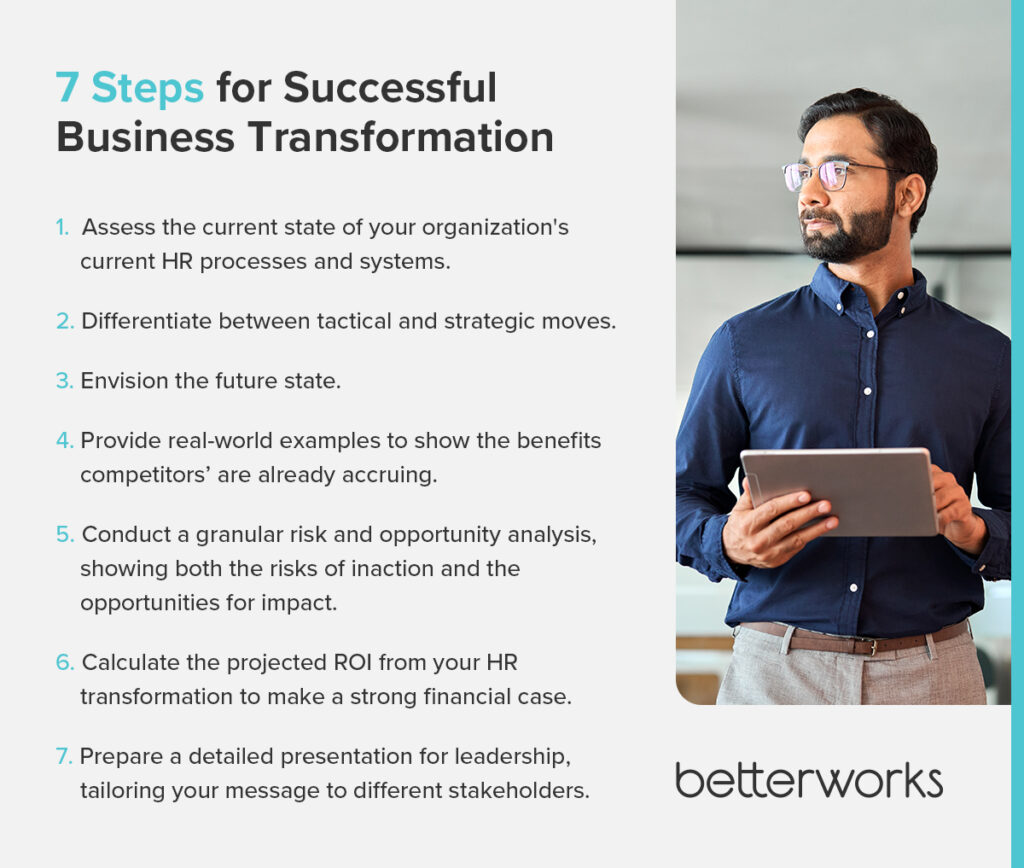- Assess the current state
- Differentiate between tactical and strategic moves
- Envision the future state
- Provide real-world examples
- Conduct a granular risk and opportunity analysis
- Calculate projected HR transformation ROI
- Prepare a detailed presentation for leadership
- Jumpstart your business case for HR transformation
As an HR leader, you have the opportunity — and responsibility — to drive significant change. But to secure resources to fund your initiatives, you must build a compelling business case for HR transformation.
The good news is that many business leaders today recognize the impact HR transformation can have on strategic outcomes. The majority (72%) recognize the importance of shifting HR from an operations function to a strategic, cross-functional discipline that better supports employee productivity, according to Deloitte’s 2024 Human Capital Trends report. Yet, despite this widespread recognition, only 41% of business leaders have made progress transitioning HR into a role that’s business-driven and transformative.
This gap presents a significant opportunity for HR professionals to step up and lead the charge. To do so, you need more than just a passion for the project — you need a compelling, data-driven business case that resonates with your leadership team. By taking the following steps, you’ll be well-prepared to present a persuasive HR transformation business case that aligns with the organization’s strategic goals.

Assess the current state
Before you can advocate for change, you need to know exactly where your organization stands now. A thorough assessment of your current HR processes and systems is essential. This assessment will not only highlight inefficiencies but also provide the data you need to measure the impact of future improvements.
Start by using this checklist to evaluate your current HR operations:
- Identify Manual Processes: Which manual processes are consuming most of your team’s time? Document them and assess how they impact efficiency.
- Assess System Integration: Are your HR systems integrated, or are they operating in silos? List any systems that don’t communicate with each other and note the consequences.
- Evaluate Employee Frustration: What are the biggest pain points for your employees? Conduct surveys or focus groups to gather qualitative data on what’s not working.
- Examine Data Accessibility: How easily can you and your leadership access key HR data? Identify any bottlenecks or limitations in your current reporting capabilities.
By following this checklist, you’ll have a clear picture of your HR programs’ current state and pain points. This is the foundation for the business case you’re building.
Differentiate between tactical and strategic moves
Not all HR changes are created equal. It’s crucial to differentiate between tactical updates — like upgrading your HRIS system — and strategic transformations — like reimagining your entire performance management process.
Tactical moves often address immediate, surface-level issues. For example, updating an outdated HR system might improve usability, but it won’t fundamentally change how your organization operates. Strategic transformations, on the other hand, are deeper and drive high-impact business outcomes. They align HR practices with long-term business goals, driving sustained growth and competitive advantage.
When building your business case, emphasize why a strategic transformation — such as shifting from traditional performance management to continuous performance enablement — offers far greater value than simply patching up existing systems. Highlight how these strategic moves will not only solve current issues but also position your organization for future success.

Envision the future state
Once you’ve clarified the distinction between tactical and strategic moves, it’s time to paint a picture of what the future could look like. This is your opportunity to inspire your leadership team with a vision of a more efficient, more effective HR function.
Consider the following key features and capabilities as you envision your future HR landscape:
- Real-Time Analytics: Integrate AI-powered tools that provide real-time insights into employee performance, engagement, and satisfaction.
- Continuous Feedback Systems: Replace outdated annual reviews with a system that allows for ongoing feedback and development, keeping employees engaged and aligned with company goals.
- Seamless System Integration: Ensure all your HR systems are connected, enabling smooth data flow and comprehensive reporting.
- Personalized Employee Experiences: Implement tools that offer personalized learning and development pathways, tailored to each employee’s career goals and performance.
- Manager Support Experience: Configurable, AI-supported tools will simplify coaching, feedback, and performance reviews while strengthening manager-employee relationships.
Creating a clear, detailed vision of the future will help your leadership team see the potential benefits of HR transformation — and why it’s worth the investment.
Provide real-world examples
Now that you’ve laid out the vision, it’s time to back it up with real-world examples. This will help make your case even stronger by showing that the transformation you’re proposing isn’t just achievable, but that your competitors are already doing it — and seeing positive results.
Take the following Betterworks customer story as an example.
Posadas, a leading hospitality company in Latin America, faced challenges with its traditional performance management system, which was outdated, time-consuming, and disconnected from the company’s strategic goals. To address these issues, business leaders at Posadas implemented a continuous performance management solution that aligned employee goals with business objectives and fostered ongoing feedback and development. (To learn more, check out our People Fundamentals podcast with Armando Smeke, strategy director at Posadas).
The transformation led to significant improvements:
- Increased Employee Engagement: By shifting to a continuous feedback model, employees became more engaged with their work and felt more connected to the company’s mission.
- Enhanced Goal Alignment: Employees could see how their individual goals contributed to the company’s overall success, leading to better alignment and collaboration across teams.
- Improved Performance and Productivity: Regular check-ins and real-time feedback allowed employees to make adjustments throughout the year, improving their performance and overall productivity.
This case demonstrates the tangible benefits of moving from a traditional, annual review process to a continuous performance management system. For HR leaders, Posadas’ success story provides a powerful example of how strategic HR transformation can drive engagement, align efforts with business goals, and ultimately, improve organizational performance.
If you have a preferred solution provider in mind, don’t hesitate to collaborate with them. Their involvement can lend further credibility to your case, particularly if they can share customer success stories from other organizations.
Conduct a granular risk and opportunity analysis
Your leadership team will want to know what’s at stake — both the risks of not acting and the opportunities that come with transformation. A detailed risk and opportunity analysis makes your case compelling.
Risks of inaction
Failing to undertake HR transformation can have serious consequences. You risk losing top talent to competitors who offer more engaging and transparent work environments. Disengaged employees are less productive, and high turnover rates can drain your resources. Additionally, reliance on manual processes and disconnected systems can lead to operational inefficiencies that slow down your business.
Outline these risks clearly. Show your leadership team what’s at stake if the organization doesn’t act.
Opportunities for impact
On the flip side, map out the opportunities that come with HR transformation. For example, implementing a modern performance management system can lead to improved employee engagement, higher productivity, and increased revenue. Adopting AI-powered HR analytics can enhance decision-making abilities so that you can optimize talent strategies and drive business growth.
Link these opportunities directly to the strategic moves you’re proposing. This will help your leadership team see the direct benefits of investing in HR transformation.

Calculate projected HR transformation ROI
With risks and opportunities clearly outlined, the next step is to quantify the potential return on investment (ROI). This is where you make the financial case for HR transformation.
Use this simple formula to calculate the ROI of your transformation initiatives, using turnover as an example:
Cost Savings = (Average Cost of Turnover per Employee) x (Reduction in Turnover Rate)
For example, if the average cost of turnover per employee is $50,000 and you expect a 10% reduction in turnover, your savings would be:
Cost Savings = $50,000 x 0.10 = $5,000 per employee
Multiply this by the number of employees you anticipate to turnover annually to estimate total savings.
Include other areas where you can add ROI calculations, such as time savings from automating manual processes and productivity gains from increased employee engagement.
However, it’s crucial to weigh these projected savings against the costs of implementing the HR transformation. Consider the following factors:
- Implementation Costs: Include expenses such as HR technology investment, software licensing, training programs, and consulting fees.
- Time and Resources: Account for the time spent by HR and other departments in transitioning to the new systems and processes.
- Change Management: Factor in the costs associated with change management efforts, such as communication strategies and additional support for employees during the transition.
Once you have a clear understanding of these costs, compare them to your projected savings and other benefits. If the expected cost savings, productivity gains, and improvements in employee engagement outweigh the transformation costs, you have a strong financial case to present to your leadership.
This comprehensive analysis helps ensure that your business case is not only compelling but also grounded in a realistic understanding of both the costs and returns of HR transformation.
Prepare a detailed presentation for leadership
The final step is to prepare a presentation that resonates with your leadership team. Tailor your message to the different stakeholders, focusing on what matters most to each.
For the CFO, for example, emphasize the financial ROI, highlighting cost savings and revenue growth. For the CIO, focus on how the transformation will integrate with existing systems and the potential for using new technologies like AI. For the CEO, align your message with the company’s overall strategy and long-term goals.
Use storytelling to make your presentation more compelling. Craft a narrative that takes your audience from the current state to the future state, using real-world examples and scenarios to illustrate the transformation journey. This will help your leadership team not only understand the benefits of HR transformation but also feel confident in the path you’re proposing.
Jumpstart your business case for HR transformation
HR transformation is essential to staying competitive in today’s business environment. By following these tactical steps, you can build a compelling business case that will resonate with your leadership team and drive meaningful change.
Want to learn more? Discover what questions to ask HR AI software vendors.
Paul Agustin is the director of solutions engineering at Betterworks, where he serves as a subject-matter expert on the technical and functional concepts of the Betterworks performance enablement solution and supports both the sales team and prospects about how the platform can be used. Previously, he helped build and scale the organization and standardize customer services.
How to define your success metrics for performance management






